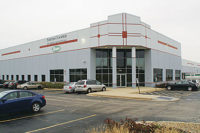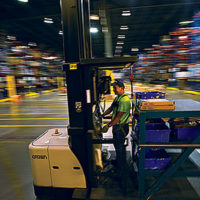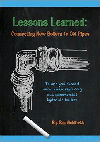Master distributors continue to provide value in the supply chain
No white flag waving.

Master distributors continue to evolve in an ever-changing supply-chain landscape. “As a master distributor, we must continue to be the broadest, deepest and most efficient company in the product categories we support,” The Stock Market’s Chip Devine says. Photo courtesy of The Stock Market.

HVACR master distributor Neuco has been proactive in upgrading its services to best help the needs of its customers. “We’ve automated our warehouse and have put a huge push on improving our electronic content,” Neuco’s Paul Neustadt says. Photo courtesy of Neuco.

Industrial Valco President Rob Raban says master distributors must be on their ‘A’ game going forward in terms of adding value to the supply chain. “The low-hanging fruit is gone and what were once specials are now commodities,” he says. Photo courtesy of Industrial Valco.



Yes, master distributors in the oil and gas sector have felt the burn of a depressed market in recent times.
“Abysmal,” is how Rancho Dominguez, Calif.-based Industrial Valco President Rob Raban describes the conditions.
Greg Wheeler, president of industrial PVF master distributor Dodson Global based out of Stone Mountain, Ga., describes 2016 as “the most challenging for the group of master distributors in the past 10 years.”
“We had many uncertainties beginning with the price of crude oil dropping, many large projects placed on hold, the presidential election and the anti-dumping suit on import flanges placed against India, Italy and Spain,” adds Wheeler, whose company is forecasting growth in 2017 and has recently joined the AD buying group.
But despite trying conditions and continued industry threats such as online competition, master distributors in both the PHCP and industrial PVF segments continue to push ahead, finding proactive ways to further add value to their respective supply chains.
Ipswich, Mass.-based United Pipe & Steel continued its expansion efforts in 2016 with its new West Coast presence that helped contribute to the industrial PVF master growing sales by double digits. “We introduced the master-distribution model to hundreds of new wholesale customers in California, Nevada, Arizona and Utah,” United Pipe & Steel President and CEO Greg Leidner says. “In our core markets, we continued to expand the number of product categories that customers buy from us.”
Companies such as St. Louis-based industrial PVF master Service Metal are focusing on time-tested fundamentals to grow business. “We grew modestly in 2016,” Service Metal President Tim Williamson says. “It was a difficult year. The demand was soft and pricing was a moving target. We spent the year focused on our core values of customer service and competitive pricing. Requests for pricing and any shipping discrepancies are handled ASAP by our staff. Our corporate structure is lean and nimble so decisions are made quickly and we are readily available to respond to all issues and concerns. Customers know they have a voice, and with this focus we managed to help our customers stay competitive and better serve their customer base in a tough year. That helped us maintain and build revenue.”
St. Charles, Ill.-based MSI-Products also zeroed in on its industrial PVF customer base. “We put in the time and effort to increase our understanding of our customers’ needs,” MSI Sales Manager/National Accounts Manager Jeff Albin says. “We visit with them and understand what’s important to them. Yes, price is important, but so is delivery and quality. We must understand what challenges our customers face and how we can best help them.”
New threats
Master distributors say there are a variety of issues they must look out for going forward. On the industrial PVF side, MSI’s Albin notes quality control is at the forefront.
“It’s the low-cost producers that focus on cheap products and maximizing efficiencies within our supply chain,” he explains. “The continual rise of the low-cost, low-quality factories lures some master distributors into focusing only on increasing margin with quality a distant second. We’ve seen markets flooded with cheap material and as a result end users find the bitterness of poor quality remains long after the sweetness of a low price is forgotten.”
Chip Devine, vice president of plumbing, kitchen-and-bath and lighting master distributor The Stock Market, points to the continued proliferation of e-commerce as something that warrants prompt attention.
“The large e-commerce businesses of the world create a level of expectation for customers not only regarding the ease of making purchases and delivery speed, but also the depth and breadth of product available,” he says. “Therefore, consumers will continue to find new and different places to buy. As a master distributor, we must continue to be the broadest, deepest and most efficient company in the product categories we support. For continued success, this must be top-of-mind every day.”
Paul Neustadt, president of Downers Grove, Ill.-based HVACR master distributor Neuco, has his company thinking along the same digital lines.
“Our 2016 finished strongly and up compared to 2015. The increase can be attributed to the continual effort to improve Neuco as a partner to our wholesale customers. Launching our new website (www.neuco.com) was a major component in this effort,” he explains. “We’ve automated our warehouse and have put a huge push on improving our electronic content.”
Masters of the now
Executives interviewed for this story say master distributors most certainly will have a continued important role in the industry, but to maintain that edge will take hard work.
“I think master distribution needs to be on its ‘A’ game to continue adding value to the supply chain,” Industrial Valco’s Raban says. “The low-hanging fruit is gone and what were once specials are now commodities.”
MSI’s Albin adds: “From our view, the role continues to evolve. With more pressure to stock product and ship quickly, master distributors have to adopt the Amazon model of quick turnaround times and high fulfillment rates.”
United Pipe & Steel’s Leidner sees the role of the master continuing to gain relevance. “More and more owners/purchasing professionals understand and quantify the benefits of this model,” he says. “Notably, the extraordinary commodity volatility we saw in 2015 and 2016 has underscored the importance of maintaining conservative inventory levels. Buying from a master distributor allows precisely that — wholesalers can maintain high fill rates, but lower their inventory levels and therefore their risk exposure when prices fall.”
Merit Brass COO Alan Lipp sees an improving landscape in 2017 for industrial PVF master distributors. “We believe 2017 will prove to be a solid if not a very good year,” he says. “There are a number of positive factors that give us cause for optimism. We expect to see raw material prices maintain their gains — at least — and oil prices to stabilize, which should, in turn, further stimulate aggregate demand levels. The Trump administration’s policies on corporate taxes, infrastructure development and regulation should support a broad and sustained rebound across most of the sectors our products serve. The big question is when the actual results will match expectations.”
Service Metal’s Williamson concurs about 2017’s prospects. “We think there will be significant upward price pressure as the price of steel already has begun an international recovery,” he says. “After 2016, the marketplace is a little less crowded and that should allow businesses to sell quality and service.”
This article was originally titled “No white flag waving” in the February 2017 print edition of Supply House Times.
Looking for a reprint of this article?
From high-res PDFs to custom plaques, order your copy today!












